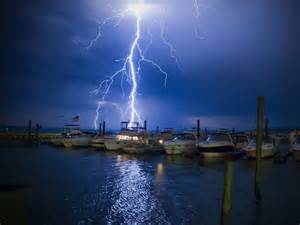
Powerful, dangerous, highly unpredictable — all are common descriptions of lightning storms. A direct strike that results only in ringing ears and a few roasted electronics would be considered lucky. Unlucky would be through-hulls blown out, a sunk boat or worse — possibly serious injury or death.
A strategy of boating only on sunny, cloudless days may work well in places like Idaho and California, but that would mean almost never using the boat in places such as Florida, Louisiana and much of the Midwest. For example, most of Florida — the Sunshine State — has at least 70 to 80 thunderstorm days per year, with some parts having more than 100 thunderstorm days per year (with increased activity during the summer months).
Boaters should track VHF, Internet and television weather reports and make responsible decisions about whether to go boating depending on the likelihood of lightning storms. Short-term forecasts can actually be fairly good at predicting bigger storms, but small, localized storms might not be reported. This is when knowing how to read the weather yourself can come in handy. (The U.S. Power Squadrons offers great weather courses for boaters, and there are many books that cover the basics.)
Lightning strikes typically occur in the afternoon. (Florida estimates 70 percent occur between noon and 6 p.m.) A towering buildup of puffy, cotton-white clouds that rise to the customary flat “anvil” top is a good indication to clear the water and seek shelter — or move out of the storm’s path if possible. That’s if the storm is at least somewhat off in the distance (most storms are about 15 miles in diameter and can build to dangerous levels in fewer than 30 minutes). If lightning and thunder are present, just count the seconds between the lightning and corresponding thunder and then divide by 5 — this will provide a rough estimate of how many miles away the storm is.
We all learn in grade school that it is not safe to be outside during a lightning storm. We also learned that lightning seeks the highest point, and on the water that's the top of the boat — typically a mast, antenna, Bimini top, fishing rod in a vertical rod holder or even the tallest person in an open boat. If possible, find a protected area out of the wind and drop anchor. If the boat has an enclosed cabin, people should be directed to go inside and stay well away from metal objects, electrical outlets and appliances (it's a good idea to don life jackets too). Side flashes can jump from metal objects to other objects — even bodies — as they seek a path to water.
Lowering antennas, towers, fishing rods and outriggers is also advised, unless they’re part of a designated lightning-protection system. Some boaters also like to disconnect the connections and power leads to their antennas and other electronics, which are often damaged or destroyed during a strike or near strike.